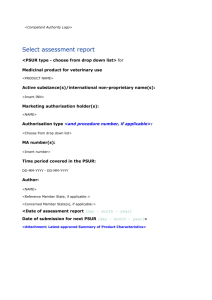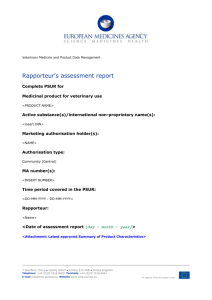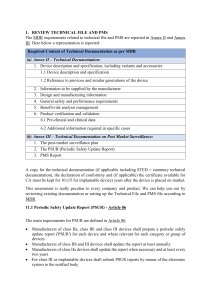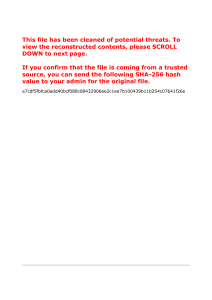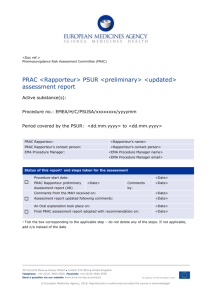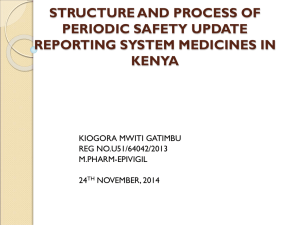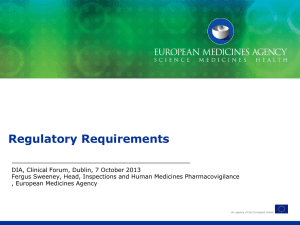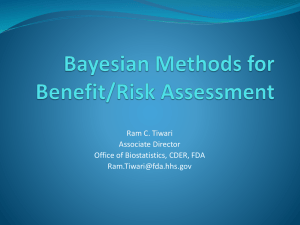Annex 1
advertisement
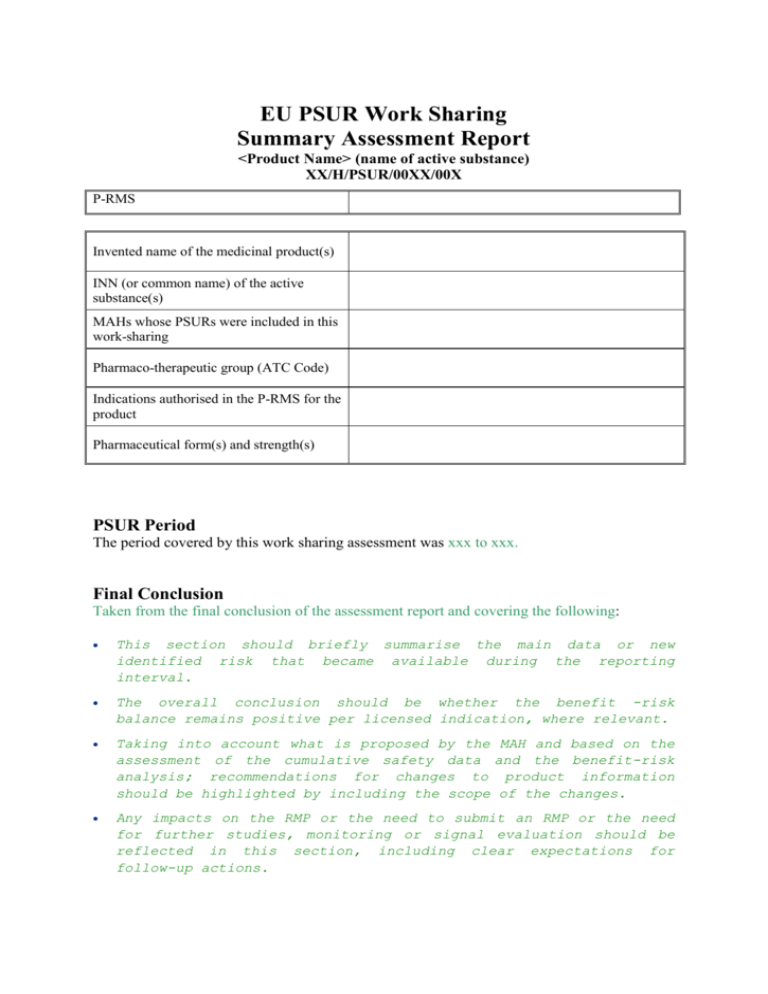
EU PSUR Work Sharing Summary Assessment Report <Product Name> (name of active substance) XX/H/PSUR/00XX/00X P-RMS Invented name of the medicinal product(s) INN (or common name) of the active substance(s) MAHs whose PSURs were included in this work-sharing Pharmaco-therapeutic group (ATC Code) Indications authorised in the P-RMS for the product Pharmaceutical form(s) and strength(s) PSUR Period The period covered by this work sharing assessment was xxx to xxx. Final Conclusion Taken from the final conclusion of the assessment report and covering the following: This section should briefly summarise the main data or new identified risk that became available during the reporting interval. The overall conclusion should be whether the benefit -risk balance remains positive per licensed indication, where relevant. Taking into account what is proposed by the MAH and based on the assessment of the cumulative safety data and the benefit-risk analysis; recommendations for changes to product information should be highlighted by including the scope of the changes. Any impacts on the RMP or the need to submit an RMP or the need for further studies, monitoring or signal evaluation should be reflected in this section, including clear expectations for follow-up actions. Any proposals for changes of the PSUR periodicity, or inclusion to the list for additional monitoring should be highlighted. In the light of the information provided in the reviewed PSUR, the P-RMS/ CMDh considers there were no new major findings affecting the overall safety profile of xxxxxxxxx and the benefit-risk profile of the medicinal product(s) remains favourable. Recommendations: Amendments to the Product Information During the assessment of the information in the PSUR the following issue was considered: (give a short summary of issue) It has been agreed that the following amendments to the Product Information are required: SmPC wording Section 4.Y Leaflet wording (if available) Agreed topics for close monitoring and review in the next PSUR are: The following adverse events should be closely monitored by the MAHs having marketing authorisation for products containing <substance>: In case generic PSURs are not requested, the generic companies are asked to report to NCAs and to the P-RMS if a signal for any of these adverse events are strengthened (statement to be included if action is required on MAs not included in the procedure). In addition, the MAH(s) should also address the following issues in the next PSUR: 2 General Guidance This template should be used by the P-RMS when preparing the PSUR assessment report. The submitted data should be summarised in a descriptive, concise and factual way. The use of tables is encouraged to summarise the data. Critical analysis of evidence should be provided predominantly in the discussion sub-sections of the assessment report. These should be based on the data and evaluations presented by the MAH in addition to any other information available to the P-RMS. Internal consistency between the descriptive part and the conclusions is vital. It is essential that new information presented in the PSUR requiring updates to product information are highlighted in relevant sections and particularly in the conclusions and actions. It should always be ensured that the recommendations for SmPC and package leaflet are fully supported in the Assessment Report. The conclusions and actions may cover a broader range of actions than the recommendations for formal regulatory action. If further data or discussions are needed to support conclusions, they should be requested in the PAR. For confidentiality reasons use, INN/name of active substance when referring to other products/comparators rather than the invented name. Taking into consideration the principles established in the HMA/EMEA recommendations of the handling of requests for access to PSURs (EMEA/743133/2009), it is not expected that the PSUR and as a consequence, the P-RMS assessment would contain commercially confidential information. Sales and exposure data are not considered confidential. However, patient personal data, date of birth, reporting country and patient identification codes are considered confidential and therefore such information should be excluded from PSUR assessment reports as far as possible. List of data sources available for guidance to be added. GVP Module VII – Periodic safety update report http://www.ema.europa.eu/docs/en_GB/document_library/Scientific_guid eline/2012/06/WC500129136.pdf 3 ICH http://www.ich.org/fileadmin/Public_Web_Site/ICH_Products/Guidelines/Efficacy/E2C/E2C_ R2_Step4.pdf GVP Module V - Risk management systems http://www.ema.europa.eu/docs/en_GB/document_library/Scientific_guideline/2012/02/WC5 00123208.pdf GVP Module VIII – Post-authorisation safety studies http://www.ema.europa.eu/docs/en_GB/document_library/Scientific_guideline/2012/02/WC5 00123204.pdf Administrative information [The following information should ONLY be included in the P-RMS AR] P-RMS contact person: Name: Tel: Fax: Email: Names of assessors (internal and external): Name(s) Tel: Fax: Email: Name(s) Tel: Fax: Email: Name(s) Tel: Fax: Email: 4 Table of contents 5 List of abbreviations 6 I. GENERAL- Steps taken for the assessment This is the assessment of PSUR(s) received for <active substance> with a DLP <date> submitted under the work sharing scheme as indicated on the cover page: Procedure Start Date Date of preliminary AR Deadline for comments to P-RMS Clockstop/ RFI / LoQ Procedure Restart Date Date of Draft Final AR Deadline for comments to P-RMS Date of Final AR Discussion at PRAC DLP of the next PSUR submission and period of PSUR II. <DD Month YYYY> N/A PSUR Data II.1. Introduction This section should provide a brief statement on the active substance, its pharmacotherapeutic action and approved indication(s), posology, pharmaceutical forms and strengths. It should also include information on the DLP, interval and cumulative periods covered by the PSUR. It should also highlight whether the MAH proposed changes to the product information as part of the submission of this PSUR. II.2. Worldwide Marketing Authorisation Status This section should include brief information provided in the PSUR with regard to the date of the first authorisation worldwide, and in how many countries the product is authorised, with indications(s), authorised dose(s), if applicable. <X was first authorised in < A on <DD Month YYYY> and> in the EU on <DD Month YYYY>. In the EU, X has been marketed in <A, B, C and D>. It is approved in a total of X countries.> 7 II.3. Overview of exposure and safety data II.3.1. Actions Taken in the Reporting Interval for Safety Reasons This section should include a description of significant actions (and reasons for these actions) related to safety that have been taken worldwide during the interval since the last DLP, related to either investigational uses or marketing experience by the MAH(s, sponsors of clinical trial(s), data monitoring committees, ethics committees or competent authorities. For further details and examples of such actions, please refer to GVP Module VII on PSURs. II.3.2. Changes to Reference Safety Information This section should highlight what Reference Safety Information is used by the MAH (e.g. CCDS, EU SmPC) and the date of the current version. The changes made during the reporting interval to the Reference Safety Information should be summarised. The P-RMS should briefly comment on whether any proposals by the MAH in terms of new safety information and key risk minimisation recommendations has been made based on the evaluation of the information provided in the PSUR and whether those are already reflected in the EU SmPC. II.3.3. Estimated Exposure and Use Patterns This section should provide estimates of the size and nature of the population exposed to the medicinal product (e.g. cumulative subject exposure in clinical trials, cumulative and interval patient exposure from marketing experience, when relevant, stratified by indication, formulation or route of administration), as well as information on patterns of drug use and any known off-label use. II.3.4. Data in Summary Tabulations It is not expected that the summary tabulations are reproduced here but the P-RMS should provide a brief comment on the outcome of the review of the data in the summary tabulation; for example, if there were any ‘striking’ adverse reaction reports what would warrant further follow-up. 8 II.3.5. Findings from Clinical Trials and other sources This section should provide a brief summary of the clinically important emerging safety findings obtained during the reporting interval from: completed clinical trials, ongoing clinical trials, long-term follow-up, other therapeutic use of the medicinal product and new safety data related to fixed combination therapies. (section 7 of the PSUR). Non-interventional studies (section 8 of the PSUR) Other clinical trial/study sources (e.g. results from pool analysis or meta-analysis of randomised clinical trials, safety information provided by co-development partners or from investigator-initiated trials, that were accessible to the MAH (section 9 of the PSUR). Literature (section 11 of the PSUR) Other periodic report (section 12 of the PSUR) II.3.6. Lack of efficacy in controlled clinical trials This section should summarise data from clinical trials indicating lack of efficacy, or lack of efficacy relative to established therapies (if applicable). II.3.7. <Late-Breaking Information> In this section the assessor should comment on any potentially important safety, efficacy and effectiveness findings that arose after the data lock point of the PSUR. Signal and Risk Evaluation In this section, there should be a description of the important safety concerns which had been recognised by the MAH at the start of the reporting period. If the product has an RMP and if it is available and with same DLP as the PSUR, the table from the RMP could be used here. 9 Alternatively, it is recommended that this section is presented in a structured manner by safety concern listing first important identified risks, secondly important potential risks and finally important missing information. Where there may be significant differences in the identified and potential risks, it may be appropriate to summarize the risks by indication, formulation or route of administration. Uncertainties previously identified could be highlighted. Tabular overview of signals: new, ongoing or closed during the reporting interval <dd.mm.yyyy to dd.mm.yyyy>. Signal term Date detected Status (new, ongoing or closed) Data closed (for closed signals) Source or trigger of signal Reason summary Method of signal evaluation Stroke MMM/YY YY New MMM/YY YY Spontane ous Brief summary of key data and rational for further evaluation Review cases, epidemiol ogical study For explanatory notes, please refer to Section VII.B.5.15 and appendix 2. Outcome, if closed GVP Module VII on PSURs, The P-RMS should comment on the signals classified by the MAH as new, ongoing and closed during the reporting interval. The P-RMS should critically assess the evidence presented in support of the MAH conclusions on safety signals – it should be made clear where the P-RMS does not agree with the MAH’s signal evaluation and/or considers further actions are needed. The P-RMS should also consider whether other signals should have been evaluated by the MAH, such as a further review of Eudravigilance data. Signal Evaluation The P-RMS should comment on the signals classified by the MAH as new, ongoing and closed, focussing on the strength of evidence and the outcome of the MAH’s evaluation. The P-RMS should critically assess the evidence presented in support of MAH conclusions on the safety signals. It should be made clear where the P-RMS does not agree with the outcome of the MAH’s signal evaluation and/or considers further actions are needed, taking into consideration as well other sources of information such as 10 Eudravigilance. The P-RMS should also consider whether other signals should have been evaluated by the MAH. Evaluation of Risks and New Information In this section, the focus should be on new risk information evaluated in the PSUR other than signals. Where a signal has been confirmed during the reporting interval and is now considered an identified risk, this should be stated in this section. Where new risks are identified, there should be consideration of whether these might be classified as ‘important’ or ‘other’ risks and whether any action is warranted e.g. any product information updates. Characterisation of Risks This section provides information in case of changes to the safety profile/ summary of safety concerns have been identified further to the above signals and risk evaluation. Otherwise, it is sufficient to state that the safety concerns remain unchanged (e.g. if the information on the risks has only been updated with most recent data with no consequences to the known safety profile. <Effectiveness of Risk Minimisation> The P-RMS should focus on implemented risk minimisation measures for important identified and potential risks, and consider whether the new data impacts on the scientific validity of existing measures. It should be concluded if the risk minimisation measures need to be strengthened or reassessed. Any comments received from MSs on national evaluations of implemented risk minimisation measures should be presented and considered if relevant to EU strategy for risk minimisation or for the benefit-risk evaluation under conditions of use in the EU. If the evidence provided by the MAH (or fed into the assessment from regulatory authorities) suggests a high level of non-adherence to risk minimisation measures, this should be brought forward as a consideration in the risk evaluation and the benefit-risk evaluation. This may be supported by increased emphasis on these risks in public health terms. 11 III. Benefit Evaluation In this section, the benefit evaluation performed by the MAH should be summarised and commented upon, distinguishing between information available at the start of the reporting interval (i.e. since last PSUR) and new information on the beneficial effects of the medicinal product. It should focus on new information (and therefore can be brief if there are no new data) and it is also important to consider whether the data have already been assessed. For medicinal products with multiple indications, populations, and/or routes of administration, the overall benefit of the medicinal product should be characterised separately by these factors. Important Baseline Efficacy and Effectiveness Information Summarise the baseline information focussing on the important benefits relating to the authorised indications recognised at the start of the reporting interval period. Newly Identified information on Efficacy and Effectiveness In relation to newly identified information on efficacy or effectiveness, focus on whether it impacts on previous knowledge of anticipated benefits in authorised indications. If any relevant new information on efficacy has emerged during the reporting interval that may help to explain observed patterns of use this needs to be considered as context for the benefit-risk balance. Characterisation of Benefits Where there is no substantial change in the risk profile or new relevant efficacy information, then this section can be quite concise and may largely cross refer to the previous section on baseline efficacy information, explicitly acknowledging that the safety profile is largely unchanged and that no new important information on benefit has emerged or the information on benefit has been positive. In this context, this section should provide an integration of the baseline benefit information and any relevant new benefit information that became available during the reporting interval in authorised indications. 12 Discussion on benefits The critical analysis of benefits should take into consideration the strengths and limitations of the evidence on efficacy/effectiveness and discuss when available: the strength of evidence of benefit, considering comparator(s), effect size, statistical rigor, methodological strengths and deficiencies, and consistency of findings across trials/studies; new information that challenges the validity of a surrogate endpoint, if used; clinical relevance of the effect size; general applicability of treatment response across the indicated patient population, e.g., information that demonstrates lack of treatment effect in a sub-population; adequacy of characterization of dose-response; duration of effect; comparative efficacy; and a determination of the extent to which efficacy findings from clinical trials can be generally applied to patient populations treated in medical practice. IV. Benefit-Risk Balance This section should represent the views of the P-RMS on the benefit-risk balance of the medicinal product, taking into account data presented in the PSUR and the arguments put forward by the MAH in the section “Integrated Benefit-risk Analysis for Approved Indications” of the submitted PSUR. If no new safety concerns or change in benefits have been identified in the PSUR assessment, this section should be concise. In case a important reporting presented full appraisal of the benefit-risk is warranted based on safety concerns and/or change of benefits during the interval period, the benefit-risk evaluation should be in a structured manner as described below: General guidance on how to describe the benefit-risk assessment: Do not repeat results extensively, these are described in detail elsewhere. Just mention the conclusions, i.e., which are the key 13 favourable/unfavourable effects that have been observed. Avoid that this section becomes the “summary of the summary”. For products approved for more than one indication, benefit-risk profiles should be evaluated and presented for each indication individually. If there are important differences in the benefit-risk balance among populations within an indication, benefit-risk evaluation should be presented by population, if possible. The key benefits and risks considered in the evaluation should be specified since not all benefits and risks contribute importantly to the overall benefit-risk evaluation. The information presented in the previous benefit and risk sections should be carried forward for integration in the benefit-risk evaluation. The strengths, weaknesses, and uncertainties of the evidence should be considered when formulating the benefit-risk evaluation. Describe how uncertainties in the benefits and risks impact the evaluation. Discuss the need for further studies or need for restrictions to product availability or usage, or any other conditions or measures aiming to improve the benefit-risk balance and reasoning for these measures. Conclude on the overall “benefit-risk balance” for the active substance and for different indications if necessary. Discuss the need for changes to the frequency of PSUR submission. Consider if the substance is under the additional monitoring list and if any changes are warranted in that respect. V. Final assessment conclusions and actions This section is intended to summarise the assessment and will be used for publication. This section should briefly summarise the main data or new identified risk that became available during the reporting interval. The overall conclusion should be whether the benefit-risk balance remains positive per licensed indication, where relevant. Taking into account what is proposed by the MAH and based on the assessment of the cumulative safety data and the benefit-risk analysis; recommendations for changes to product information should be highlighted by including the scope of the changes. 14 Any impacts on the RMP or the need to submit an RMP or the need for further studies, monitoring or signal evaluation should be reflected in this section, including clear expectations for follow-up actions. Any proposals for changes of the PSUR periodicity, or inclusion to the list for additional monitoring should be highlighted. VI. <Request for supplementary information> This section should only be included in the P-RMS’s preliminary AR for the MAH to address during the clock-off period. Only questions critical to the assessment of the benefit/risk balance should be considered. Other questions should be included in the recommendations to be addressed in future PSURs. VII. Recommendations [In case of recommendation to maintain the marketing authorisation without amendment to the product information] Based on the <P-RMS> review of data on safety and efficacy, the <P-RMS> considers that the benefit-risk balance of medicinal products containing the active substance <name of active substance> remains favourable and therefore recommends the maintenance of the marketing authorisation(s). [In case of recommendation to amend the product information] Based on the review of data on safety and efficacy, it is considered that the benefi-riskt balance of medicinal products containing the active substance <name of active substance> remains favourable but recommends that the terms of the product information should be amended as follows: [The scope of changes to the SmPCs and Package leaflets should be highlighted here with a detailed description of the new text underlined and deleted text marked as strikethrough presented in Annex 1]. Update of section X and X of the SmPC with regard to <adverse reaction> <to add a warning on>. The Package leaflet is updated accordingly. [In cases where other changes to the marketing authorisation are recommended such as new risk minimisation measures, these should also be described here and presented in and optional annex [Annex 2]. The amendments recommended to be introduced to the product information are included in Annex 1. 15 [In all cases, choose as applicable]- it should also be stated whether this applies to all products containing the active but are not required to submit PSURs e.g. generics <In addition, the MAH(s) should also address the following issues in the next PSUR :> <In addition, the MAH(s) should submit an updated RMP within x months in order to address the following issues :>[Optional] 16 VIII. I. II. List of annexes Recommended changes to the product information Any other recommended changes or risk minimisation measures (optional) 17 ANNEX I RECOMMENDED CHANGES TO THE PRODUCT INFORMATION The following changes to the product information of medicinal products containing the active substance <name of active substance> are recommended: Summary of product characteristics [Add sections as relevant] Section 4.4 A warning should be <added> <revised> as follows: <exact wording of final warning> Section 4.8 <The following adverse reaction(s) should be added under the SOC <name of SOC> with a frequency <frequency>: < The frequency of the adverse reaction <name of ADR> should be changed to <very common> <common etc…> Package leaflet [Add sections as relevant, ensuring that the above proposed changes to the SmPC are adequately reflected, in lay terms, in the package leaflet] 18 ANNEX II ANY OTHER RECOMMENDED CHANGES OR RISK MINIMISATION MEASURES 19
